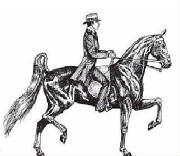| Higher Headset Hand Position |

|
| Lower Headset Hand Position |

|
Ideal Saddle Seat Equitation Riding Position Overview
Maintaining center of balance: Rider's back should be straight, with shoulders directly over hips and
spine in line with that of horse. Leaning down over horse to check leads and/or diagonals should be severely penalized. Ideally,
a rider should be able to feel the correct lead and diagonals, but if they must be checked, only a glance downward with the
eyes is appropriate. However, a rider who leans over and obtains a correct lead or diagonal should be scored above a rider
who glances down but obtains and maintains an incorrect lead or diagonal.
Arms: Elbows should be no further from the body than the point at which the chest begins to look concave.
This is called "pumpkin arms" or cave-chested because improper roundness of the arms forces the chest to cave inward and the
shoulders to come forward out of position. The upper body, including the arms and hands, should give the appearance of elegant
style and complete control but without the impression of stiffness, posing or exaggeration.
Hands: Hands should be quiet and light, with flexible (not locked) wrists and should show sympathy, adaptability
and control. Horses with high-set necks allow the rider's hands to be held higher than do horses with low-set necks; therefore,
the placement of the horse's neck dictates the proper elevation of the rider's hands. Hands should be tipped in 30-45 degrees
from vertical and should not be excessively far apart (not more than 8 inches in most cases). Bight of reins is on off (right)
side. Constant bumping of the horse's mouth or excessive shortening of the reins is distracting and should be avoided.
Legs and Feet: The old days of the flared lower leg and cocked ankle are long gone. It is easy to see
why, as this unnatural leg and foot position did not allow the rider to properly guide the horse using calf pressure. With
feet in stirrups, the stirrup leathers should hang straight down, should never be twisted and should be even on both sides.
The whole body is important while riding. Correct equitation allows the horse to move unhindered by the rider,
makes it easy for him to understand cues, and creates a beautiful picture.
Colleen Kelly Rider Biomechanics
Upper Body Articles
Is Your Upper Body in the Proper Position? by Julie Goodnight
Develop Model Hands - Ideal equitation varies among disciplines but good hand position is critical to effective communication
between rider and horse.
Proper Riding Posture from the Rider's Training Scale (scroll down to Body Awareness)
Developing a Following Seat Sally Swift explains how "riding with your bones" releases tensions, corrects imbalance, and permits
harmonious, precise movement on horseback.
Rider's Posture
The Pointe of Good Posture (ballet posture)
Lower Body Articles
Your Seat and the Saddle (go to paragraph starting with "The thigh bone")
Correct Stirrup Length by Julie Goodnight
Strong Leg, Safe Seat. A picture perfect position with a solid foundation is required to be in the ribbons in western horsemanship
classes. Subtle improvements that create a balanced seat might make the difference in your performance.
The Balanced Position De-Mystified
Improving Lower Body Position by Julie Goodnight
|



